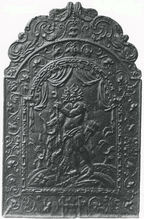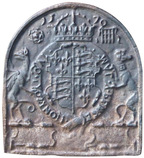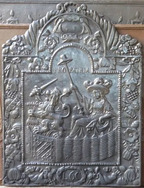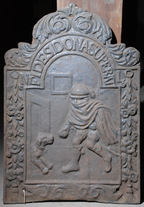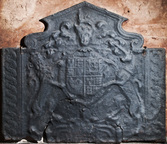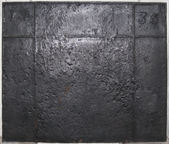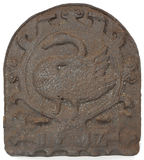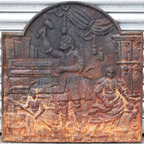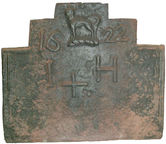-
157
Description: Arched rectangular shaped central panel with paternost bead edging; figure holding a bow in his left hand and a lyre in his right hand, a quiver suspended from his belt, on an undulating ground with small trees, and suspended swags of drapery above; Arched rectangular shaped border with fillet edging, and symmetrical flowers and swirled tendrils; initials at bottom centre; on top, symmetrical pattern of swirled leaves and tendrils.
Notes: The figure is Apollo, personifying the Sun, one of a set of 'Eight Deities' engraved by Hendrick Goltzius (1592), after Polidoro da Caravaggio; the fireback is one of a large group bearing the same initials, which probably denotes the pattern maker. Other groups may have been the work of the same carver or workshop. The execution is rather crude. Formerly part of the J. H. Every collection.
Copies of this fireback are known.
Inscription: SHR
- Decoration tags:
- 'Dutch' (shape)
- fillet (edging)
- whole carved pattern
- planklines
- mythological
- monogram
- text
Manufactured: in the late-17th to early-18th century in England.
Current location: Anne of Cleves House, Southover High Street, Lewes, East Sussex, England.
Museum number: 1944.24.73 (part of the Sussex Archaeological Society museum group)
- Attached to series:
- SHR series
- British 'Dutch' style firebacks
- Eight Deities series
-
1135
Description: Arched shape; fillet edging; top centre, date; decorative Tudor royal shield, crown, garter (motto clockwise but reversed) and supporters (dragon and greyhound); a rose to the left and a portcullis (grid of 6) to the right side of crown; the supporters stand on a horizontal compartment which, on similar firebacks, often contains the date.
Notes: There are several firebacks with the Tudor royal arms that were probably originally produced in the Spanish Netherlands, perhaps illustrating the association between England and Spain through the marriage of Henry VIII and Katherine of Aragon. The firebacks differ in several small details, such as the form and rotation of the Garter motto, the style of the crown, the positioning of the supporters in relation to the Garter, and the form and size of the rose and portcullis.
Inscription: 15 70 / HONY SOYT QVI MAL Y PENSE
Arms: English royal Tudor
- Decoration tags:
- rounded arched (shape)
- fillet (edging)
- whole carved pattern
- individual numbers
- heraldic
- armorial
- text
Manufactured: in 1570 possibly in the Wallonia area of Luxemburg.
Current location: not known.
- Attached to series:
- Tudor royal armorial firebacks
- Continental Tudor royal armorial firebacks
-
1212
Description: Arched rectangular central panel with bead edging; wickerwork Garden of Holland (Hollandse Tuin) within which is seated a berobed female figure holding a cap of freedom on the end of a long pole; before her is the crowned heraldic lion of the States General of the Netherlands, clutching a sheaf of arrows in its left front paw; above are the words, Pro Patria; arched rectangular border with fillet edging; central cartouche at top, with festoons of fruit, flowers and leaves suspended on each side from ribbons supported by rings; at the bottom, swirled ribbon around an oval compartment bearing the inscription 'L6C'; on top, a central cartouche from which descend a cornucopia on each side of the arch.
Notes: An overtly patriotic theme with symbols of Dutch nationhood; the inscription at the bottom indicates the style of border; other firebacks with the same inscription have the same border; similar inscriptions (e.g. L7C and L8G) indicate different borders.
Inscription: PRO PATRIA / L6C
- Decoration tags:
- 'Dutch' (shape)
- fillet (edging)
- whole carved pattern
- pictorial
- allegorical
- text
- animals
- humans
- plants
- objects
Manufactured: in the late-17th century in the Siegerland area of Germany.
Current location: not known.
- Attached to series:
- 'Dutch' LC/G series
- 'Dutch' Garden of Holland firebacks
-
1139
Description: Carved wooden fireback pattern. Arched rectangular shape; fillet edging to a rounded frame with sections of acanthus leaves at the corners and at the top of the arch, and blank campartments in between; astragal and fillet inside edging; arched rectangular inscription scroll suspended with faux ribbon from the top of the arch; below, a coronet over a large baroque cartouche containg two oval shields: Massenbach - azure two bars or, d'Helmstadt - argent a crow sable; on either side, lion rampant reguardant supporters; four vertical planklines.
Notes: A finely executed carving. Nicolas de Massenbach (1659-1722) and Francoise d'Helmstadt (d.1729) were married at Ourches-sur-Meuse, in Lorraine, in 1695.
Inscription: NDM 1710 FDH
Arms: Nicolas de Massenbach and Francoise d'Helmstadt
- Decoration tags:
- rectangular with round arch (shape)
- fillet (edging)
- whole carved pattern
- planklines
- heraldic
- armorial
- text
Manufactured: in 1710 in France.
Current location: not known.
Citation: Palasi, P., 2014, Plaques de Cheminées Héraldiques (Paris, Éditions Gourcuff-Gradenigo).
- Attached to series:
- Patterns
-
844
Description: Arched rectangular central panel; fillet edging; pictorial scene of a cloaked figure, to the right, tempting a dog, to the left, with a tasty morsel; behind are the outlines of a door and window; arched rectangular border with fillet edging, the date along the bottom; down each side, a floral festoon; over the arch, the inscription, the initials split between each side of the main inscription; on top, floral scrolls.
Notes: The inscription translates as 'loyalty above gifts'; some castings omit the initials, NL, indicating that they were a subsequent addition. The illustration is derived from 'The thief and the dog', one of a series of engravings of Aesop's Fables by Wenceslaus Hollar.
Copies of this fireback are known.
Inscription: N / FIDES DONA SUPERAT / L // 1696
- Decoration tags:
- 'Dutch' (shape)
- fillet (edging)
- whole carved pattern
- individual letters
- planklines
- pictorial
- allegorical
- text
- animals
- humans
Manufactured: in 1696 possibly in the Siegerland area of Germany.
Current location: English Heritage Store, Atcham Business Park, Atcham, Shropshire, England.
Museum number: EH ASC 4491 (part of the English Heritage museum group)
- Attached to series:
- 'Dutch' 1696 NL series
-
1319
Description: Rectangular with pediment raised on inverted consoles; fillet edging, ovolo-moulded in the pediment; shield, garter, helm, mantling, crest of a lion surmounting a chapeau, and motto cartouche with obliterated text; on each side, an extension panel with a vertical guilloche pattern.
Notes: One of several firebacks, all varying in size, framing style and moulding, with stylistic features in common and almost certainly the work of the same pattern maker, who was also responsible for carving royal coats of arms in several West Country churches. The presence of the chapeau, or Cap of Maintenance, is unusual on arms of this period, it being more common on medieval achievements.
Copies of this fireback are known.
Arms: English Stuart royal
- Decoration tags:
- rectangular with detached pediment (shape)
- fillet (edging)
- whole carved pattern
- extension panels
- heraldic
- armorial
- royal
Manufactured: in the early-17th century in England.
Current location: Barnstaple Guildhall, Butchers Row, Barnstaple, Devon, England.
- Attached to series:
- Bristol armorial group
- Stuart royal armorial firebacks
-
203
Description: Rectangular; fillet edging; fillet parallel to top edge separating top quarter; two fillets parallel to sides separating side quarters; halves of date in top corner squares.
Notes: Numeral style is typical of first half of 18th century.
Inscription: 17 36
- Decoration tags:
- rectangular (shape)
- fillet (edging)
- individual numbers
- text
Manufactured: in 1736 in England.
Current location: Selly Manor, Birmingham, West Midlands, England.
(part of the Selly Manor museum group)
- Attached to series:
- Date only firebacks
-
889
Description: Arched shape; fillet edging; swan within a voided strapwork cartouche; date in Arabic numerals, at bottom, on a broad horizontal fillet.
Notes: Stylistically, of the early 17th century, suggesting the date is 1617, although the third numeral is indistinct. Bonham's sale, Chester, 18 October 2012, lot 384 (£375).
Inscription: 16 1[?]7
- Decoration tags:
- rounded arched (shape)
- fillet (edging)
- whole carved pattern
- heraldic
- architectural
- text
- animals
Manufactured: in 1617 in England.
Current location: not known.
- Attached to series:
- Miscellaneous pattern firebacks
-
1269
Description: Arched rectangular shape; fillet edging; central male figure clothed in 17th century style, facing to the left, holding a mallet in his raised right hand and holding a board with rectangular detailing in relief in his left hand; vertical boards in relief behind; below to the left, a smaller figure holding a long pole diagonally with other detailing in relief behind; to the lower right, a female figure, contemporaneously clothed, a scroll feature to her right; behind, an archtectural grille with scrolled detailing; above, swagged drapery with three descending tasselled ropes.
Notes: A pastiche of a 17th century fireback. The scene appears to be of a carpenter's workshop but some of the detail in the lower parts of the fireback is indistinct owing to corrosion. The drapery was probably inspired by a similar feature on several late-17th or early-18th century 'Dutch'-style fireback designs. The reverse (upcast) side of the fireback is very smooth indicating a modern date for the casting.
- Decoration tags:
- rectangular with round arch (shape)
- fillet (edging)
- whole carved pattern
- pictorial
- humans
- objects
Manufactured: in the 20th century in France.
Current location: Raflees Reclamation Ltd, Trefusis Lodge, Tone Green, Bradford-on-Tone, Somerset, England.
- Attached to series:
- Miscellaneous pattern firebacks
-
206
Description: Rectangular with two-stepped top; double astragal edging on sides; top centre, stamp formed of a talbot statant guardant upon a wreath; date split either side of crest; initials below date, ‘+’ below letters.
Notes: The talbot crest is seen on other firebacks indicating a common source.
Copies of this fireback are known.
Inscription: 16 22 / I + H
- Decoration tags:
- stepped (shape)
- fillet (edging)
- simple stamps
- carved stamps
- individual numbers
- heraldic
- text
Manufactured: in 1622 in the Weald area of England.
Current location: St Mary's House, Bramber, West Sussex, England.
- Attached to series:
- Talbot crest series
- Stepped firebacks
